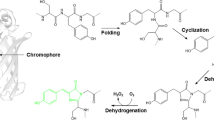Summary
Three retinal-containing pigments have been detected inHalobacterium halobium membranes: bacteriorhodopsin (bR), halorhodopsin (hR), and slow-cycling rhodopsin (sR). The first two hyperpolarize the cell membrane by electrogenic transport of H+ and Cl−, respectively. The third pigment, sR, may be a photosensory receptor since mutants lacking bR and hR retain their retinal-dependent phototaxis responses. We monitored light-induced changes in fluorescence of several voltage-sensitive dyes in cells and membrane vesicles. Red light-induced potential changes generated by bR and hR were similar to signals described previously. Signals generated by hR could be identified using four criteria: wavelength dependence, Cl− dependence, shunting by valinomycin and K+, and the absence of these signals in hR-deficient mutants. The absence (detection limit ∼0.5 mV) of hyperpolarization signals in bR−hR−sR+ vesicles and cells shows that sR photochemical reactions are nonelectrogenic. Two signals independent of bR and hR were measured: blue light caused a decrease and red light an increase in dye fluorescence. Both signals appear to derive from sR on the basis of their retinal-dependence and action spectra. In a retinal-deficient mutant strain (Flx3R), both sR signals appeared after addition of all-trans retinal. In this strain retinal also restores phototaxis sensitivity within the same time scale. The retinal concentration dependence for all four parameters monitored—the attractant (red) and repellent (blue) phototaxis, and the red light and blue light-induced fluorescence signals—is the same. This correlation is consistent with the hypothesis that both attractant and repellent responses are mediated by sR, as suggested by Bogomolni and Spudich (Proc. Natl. Acad. Sci. USA.79:6250–6254 (1982)).
Similar content being viewed by others
References
Bogomolni, R.A. 1984. Photochemical reactions of halorhodopsin and slow-rhodopsin.In: Information and Energy Transduction in Biological Membranes. E. Helmreich, L. Bolis, and H. Passow, editors. Alan R. Liss, New York (in press)
Bogomolni, R.A., Spudich, J.L. 1982. Identification of a third rhodopsin-like pigment in phototacticHalobacterium halobium.Proc. Natl. Acad. Sci. USA 79:6250–6254
Dencher, N.A., Hildebrand, E. 1979. Sensory transduction inHalobacterium halobium: Retinal protein pigment controls UV-induced behavioral response.Z. Naturforsch. 34:841–847
Ehrenberg, B., Meiri, Z., Loew, L.M. 1984. A microsecond kinetic study of the photogenerated membrane potential of bacteriorhodopsin with a fast responding dye.Photochem. Photobiol. 39:199–205
Grinvald, A., Hildesheim, R., Farber, I.C., Anglister, L. 1982. Improved fluorescent probes for the measurement of rapid changes in membrane potential.Biophys. J. 39:301–308
Gupta, R.K., Salzberg, B.M., Grinvald, A., Cohen, L.B., Kamino, K., Lesher, S., Boyle, M.B., Waggoner, A.S., Wang, C.H. 1981. Improvements in optical methods for measuring rapid changes in membrane potential.J. Membrane Biol. 58:123–137
Hildebrand, E., Dencher, N. 1975. Two photosystems controlling behavioral responses ofHalobacterium halobium.Nature (London) 257:46–48
Krasne, S. 1980. Interactions of voltage-sensitive dyes with membranes. II. Spectrophotometric and electrical correlates of cyanine-dye adsorption to membranes.Biophys. J. 30:441–462
Lanyi, J.K., Schobert, B. 1983. Effects of chloride and pH on the chromophore and photochemical cycling of halorhodopsin.Biochemistry 22:2763–2769
Lindley, E.V., MacDonald, R.E. 1979. A second mechanism for sodium extrusion inHalobacterium halobium: A light driven sodium pump.Biochem. Biophys. Res. Commun. 88:491–499
Loew, L.M., Cohen, L.B., Salzberg, B.M., Obaid, A.L., Bezanilla, F. 1984. Charge shift probes of membrane potential. Characterization of aminostyrylpyridium dyes on the squid giant axon.Biophys. J. (in press)
Matsuno-Yagi, A., Mukohata, Y. 1980. ATP synthesis linked to light-dependent proton uptake in a red mutant strain ofHalobacterium lacking bacteriorhodopsin.Arch. Biochem. Biophys. 199:297–303
Renthal, R., Lanyi, J.K. 1976. Light-induced membrane potential and pH gradient inHalobacterium halobium envelope vesicles.Biochemistry 15:2136–2143
Schobert, B., Lanyi, J.K. 1982. Halorhodopsin is a light-driven chloride pump.J. Biol. Chem. 257:10306–10313
Sims, P.J., Waggoner, A.S., Wang, C.-H., Hoffman, J.F. 1974. Studies on the mechanism by which cyanine dyes measure membrane potential in red blood cells and phosphatidylcholine vesicles.Biochemistry 13:3315–3330
Spudich, E.N., Spudich, J.L. 1982. Control of transmembrane ion fluxes to select halorhodopsin-deficient and other energy-transduction mutants ofHalobacterium halobium.Proc. Natl. Acad. Sci. USA 79:4308–4312
Spudich, J.L. 1984. Genetic demonstration of a sensory rhodopsin in bacteria.In: Information and Energy Transduction in Biological Membranes. E. Helmreich, L. Bolis, and H. Passow, editors. Alan R. Liss, New York (in press)
Spudich, J.L., Bogomolni, R.A. 1983. Spectroscopic discrimination of the three rhodopsinlike pigments inHalobacterium halobium membranes.Biophys. J. 43:243–246
Spudich, J.L., Stoeckenius, W. (1979). Photosensory and chemosensory behavior ofHalobacterium halobium.J. Photobiochem. Photobiophys. 1:43–53
Stoeckenius, W., Bogomolni, R.A. 1982. Bacteriorhodopsin and related pigments of halobacteria.Annu. Rev. Biochem. 52:587–616
Author information
Authors and Affiliations
Rights and permissions
About this article
Cite this article
Ehrlich, B.E., Schen, C.R. & Spudich, J.L. Bacterial rhodopsins monitored with fluorescent dyes in vesicles andin Vivo . J. Membrain Biol. 82, 89–94 (1984). https://doi.org/10.1007/BF01870735
Received:
Issue Date:
DOI: https://doi.org/10.1007/BF01870735




